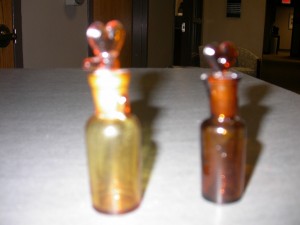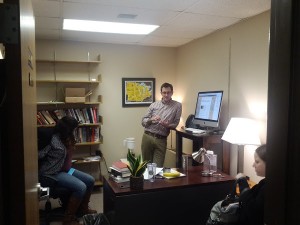Today I began two transcriptions which, though similar in focus, couldn’t have resulted in more diverse work experiences. One was an individual monologue about the gay scene in Kansas City since the 1960s. The other was a round table discussions of the different experiences of a group of lesbians in Kansas City. While the monologue flowed fairly smoothly and demanded more focus on grammatical form, due to the narrators use of pauses and vocal delivery, the round table require more nuanced attention. With frequent interruptions, laughter, and joking among the narrators as they seamlessly flowed off of and into each others conversations, I found myself needing to stop and learn the narrator’s unique voices. While the first project demanded I try to understand the rhythm and meaning of the narrator’s delivery (to know what should be a period or comma), the other demanded I listen for distinct voice markers.
In both cases I needed to hear the individual quality of the narrator’s voice, but in different ways. I couldn’t simply type out what I heard. In the monologue, without first hearing the narrators rhythm and broader topic, I could very easily structure the statements incorrectly. In the round table interview, the general lack of names being given before speaking and the boisterous free-flow of conversation, left me confused without better context. Though both required topical context, the round table drove me to become familiar with the voices themselves. In both transcriptions I needed to start orienting myself a few minutes into the recording, not at the beginning. This was a new experience compared to those stories I had heard since childhood which start at, you guessed it, the beginning. I needed to not only hear the rural style to “Pat’s” Midwestern voice as opposed to the higher pitched, New Jersey fast pace of Giselle’s voice; but I also needed to hear the more nuanced differences between the rich tones of Sue’s Davenport voice and Bev’s Kansas City voice.
The longer I listened, over and over, I started to hear the vocal tones of different laughs and the patterns of different speakers. I began to become familiar with their voices, to know them. I began to really hear them. Sometimes foreign to the historical voices of monographs and journal essays, the recordings brought be into a more challenging and more personal type of history. It was challenging, disorienting, and a little unsettling. But it was also beautiful. The struggle to discover the voices of the historical agents was present, just like in other forms of research, but in new ways. It wasn’t enough to hear the narrator’s voice, to get their words, but I had to discern their voice for its distinct qualities. It wasn’t enough to know the words and actions of the historical agent, but what makes them different from other historical agents. Today was a wonderful example of literally learning to hear the voices of those in the past who I had never heard before, and I can’t wait to hear what they will say next.


